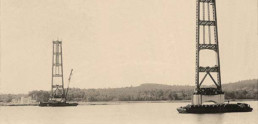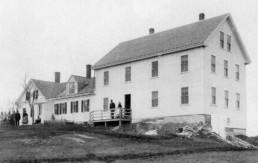The Year Steel and Cable Changed Deer Isle
The Year Steel and Cable Changed Deer Isle
Does an island lose its “islandness” when a bridge is built linking it to the mainland? For Deer Isle and Little Deer Isle, the question is not hypothetical. For the last 75 years, a bridge has wrought changes to the two Penobscot Bay islands and to Stonington, the busy fishing harbor at their southernmost tip. Although the distance across Eggemoggin Reach from Little Deer Isle to the village of Sargentville is only half a mile, that gap seemed much greater until the Deer Isle–Sedgwick Bridge was built in 1939.
Before the bridge, most supplies came by steamer from Rockland, or by a ferry service operated by generations of the same family on Little Deer Isle. The bridge changed the region’s economy and culture. It changed the direction toward which residents looked for mainland connections, making it more part of the Blue Hill peninsula than Penobscot Bay. In many ways, it changed the island’s self-image. Although the bridge brought a freedom of mobility that allowed residents to join the 20th-century love affair with the automobile and the open road, Deer Isle was not exactly a remote, isolate outpost before 1939. Settlers began to arrive on Little Deer and Deer Isle before the Revolution. At the time the town was incorporated in 1789, it included Little Deer Isle, Deer Isle, and Isle au Haut, six miles to the south of Stonington at the southern tip of Deer Isle. In 1868 Isle au Haut became a separate town, and in 1897, the southern third of Deer Isle was incorporated as the town of Stonington. A ferry service linking Little Deer Isle to the mainland, documented in the Deer Isle–Stonington Historical Society’s records, began on April 17, 1792, when John Scott, son of an early settler, was employed by the town to row islanders across Eggemoggin Reach. In 1807, the town granted Scott $80 to construct ferry landings on both sides of the Reach. The Scott family’s ferry remained the chief contact with the outside world until the discovery of granite in the Stonington area in the mid-19th century. The small community on the southern end of Deer Isle, then known as Green’s Landing, thrived, and was incorporated into the town of Stonington. That development changed island transportation patterns. Steamers were soon transporting granite and carrying passengers and supplies west across Penobscot Bay to the rail link at Rockland.
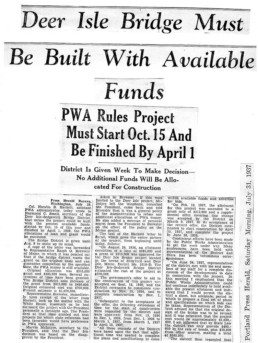
Meanwhile, generations of the Scott family continued to provide ferry service for the inhabitants of Little Deer Isle, which today is linked to Deer Isle by a boulder-lined causeway. (Then, passage from Deer to Little Deer could be made across the flats at low tide by traveling a serpentine course from rise to rise; the causeway follows that same snake-like course today.) By 1900, however, the arrival of the automobile led to dissatisfaction with the limitations of the ferry, at that time run by a Scott descendant named Charles and his son Maynard. The 50th anniversary of the bridge in 1989 was marked by Clayton Gross in Steel over Eggemoggin: A History of the Deer Isle–Sedgwick Bridge. He wrote: “Perhaps the blame can be laid at the door of Henry Ford, whose Model T flooded the nation and within a period of ten years literally put the country on wheels.” By the end of World War I, the number of vehicles on Deer Isle had increased to the point where Scott’s ferry had become inadequate.
BEFORE THE BRIDGE
Hilda Eaton Stacher grew up on Little Deer Isle in the early 20th century. After graduating from the University of Maine, she returned to teach school on the island and run the Little Deer Isle post office. In 1989, she described life before the bridge in the local newspaper:
When I was growing up and we went to the mainland, we had to consider not only the departure time of the last ferry, but also the periods of low tide. One of the great frustrations of life was to arrive at the ferry landing and see the last ferry halfway across the Reach, heading towards North Deer Isle. We were also served by the Eastern Steamship lines, which operated between Boston and Rockland. Since the Reach usually froze solid in the winter, service was suspended until the first trip in the spring, which was often made while preceded by an icebreaker. Fortunately, island storekeepers usually laid in supplies of staples like flour and sugar for the long winter ahead.
Cabbage “Cab” Haskell also grew up on Deer Isle, and provided a candid view of life before and immediately after the bridge was built: “The working-class people lived in Stonington and didn’t go to college. The Little Deer Isle folks went to college, were yacht captains, summer folks, etc.” He was even more blunt about the impact the bridge had on population: “It allowed folks to get the hell out of there,” he said. Haskell moved from the island to Philadelphia in the early 1950s, where he spent most of his adult life. Haskell kept a house on the island, however, and returned after his wife’s death. Everything depended on the steamboats from Rockland, he remembered, the north haven and the w. s. white, one of which came to the island once a day. “Before the bridge, Deer Isle was a foreign country,” he said. And in those early years of the 20th century, the Scott family ferry service lacked a measure of professionalism, he said. “If they didn’t like you, they wouldn’t take you,” Haskell claimed. He has no memory of traveling across on Scott’s ferry because his father and Scott didn’t get along. “He wasn’t a popular guy,” Haskell said of Scott. Haskell met his future wife Pam at a dance during those pre-bridge years. She was from Philadelphia, and her family summered on the island each year, driving to Deer Isle and coming over on Scott’s ferry. Haskell recalls that they had to get to the landing before it stopped running at 8 p.m. At the time Scott had a barge with a lobster boat tied alongside that took four cars at a time.
A BRIDGE IS BORN
Haskell said the bridge was built for commercial purposes. “A bunch of prominent businessmen saw it as an opportunity to transport freight on and off the island more easily, and to get stones from the quarries to the mainland faster,” he said. And the timing was right. In those Depression days of the 1930s, federal money was available for public works projects, through the Works Progress Administration (WPA) and the Public Works Administration (PWA). But the idea of the bridge was born well before President Franklin Roosevelt’s recovery programs took shape. During the 1920s, local and regional leaders hosted meetings to talk about upgrading the ferry service, but those efforts were only partially successful. Charles Scott attempted to respond to concerns by adding larger scows capable of carrying up to six cars. In 1927, he added a second towboat. Another development that same year brought the bridge idea closer to reality. Representative George E. Snowman, the state legislator from Little Deer Isle, introduced a bill to build a causeway at Scott’s Bar, connecting that island with the larger Deer Isle. Snowman’s proposal won passage, and $15,000 was allotted for the project. The causeway was begun that year, but not completed until 1938. The state transportation department added locally quarried stone barriers to the sides in 1946.
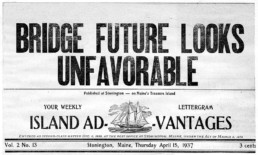

BRIDGE OR FERRY?
During the next few years, the bridge question became the hot topic of discussion. Not everyone favored it, with the cost a major concern. Why not simply improve the ferry service instead? By 1933, however, the opposition to a bridge had begun to dwindle. “Upgrading the ferry service was a difficult proposition during the depths of the Depression,” said island historian Clayton Gross. “Large amounts of capital were needed to construct a new ferry.” And if it were built, weather would still hinder reliability, he said. That case was made in March 1933 when several cars arrived on the mainland side of Scott’s ferry at Sargentville only to find it not running because of high winds and rough seas. Drivers waited all day before returning to Blue Hill to spend the night. The next day they returned at 8 a.m. and were forced to wait until 3 p.m. before the ferry was finally able to take them across in very bad weather. Clearly the ferry service had become outmoded. During the winters of 1934 and 1935 it was frequently inoperable because of severe weather conditions. And it was more than cars. Ice prevented steamers from bringing fuel to Stonington. It was of little consolation that the Reach was frozen so solidly that adventurous drivers were able to drive across in those years. Alternatively, in the summer as many as 40 cars at a time could be seen lined up at Sargentville waiting to get to the island. Something had to be done. In December 1933, Stonington, Deer Isle, and Sedgwick each appointed two trustees to form a bridge commission. The following summer they visited Governor Louis Brann to lobby for his support. The next year, Brann signed a bill creating the Deer Isle–Sedgwick Bridge District, although it would be five years before a firm commitment was made to construction. Financing, location, design, and winning public support were the next challenges. More than once, it seemed the idea had died. Committees were formed, studies were made, and, as one newspaper article noted, “[T]he bridge project was kicked from one end of the state to the other as being a worthless and expensive proposition beyond reasonable realization.” Finally, in 1935, Bridge District president Frank McGuire secured two large PWA grants, the cornerstones on which the bridge would be built. Authorization for a $500,000 bond required a statewide referendum, and it was put on the ballot in 1935. At the time there were 426 cities and towns in Maine, and the bridge trustees spent endless hours visiting more than three-quarters of them to make their case. When the votes were tallied, the project was approved by a ratio of three to one. Then in November 1936, McGuire, a tireless worker for the project, suddenly died. His obituary noted, “He had laid a firm foundation which weathered many a storm.” His place was taken by Stephen Knowlton, who also would die before the bridge was completed. Although the federal government supported the project, its engineers initially insisted that the bridge be of a sufficient height for large ships to pass beneath. This meant a clearance of 100 to 110 feet, which would have added considerably to the expense and further complicated the design. A. Cressy Morrison, a prominent scientist and author of the day who owned a small island off Stonington, was enlisted to lobby for a lower bridge height. (Local lore holds that the Rockefellers on nearby Mount Desert Island wanted the bridge high enough so their sailing yachts could cruise Eggemoggin Reach.) After considerable discussions with the War Department and WPA offices in New York and Washington, Morrison was able to secure approval for a bridge with 85 feet of clearance off the water, which was still high enough for pleasure yachts to sail under. The Deer Isle–Stonington Messenger noted, “We are indebted to Mr. Morrison for his timely assistance and efficient work.” Bonds were issued, bids accepted, rejected, revised, reopened, and extended. The Messenger, in understated terms, summarized the process, saying: “The vicissitudes which the bridge project went through were many.” In October 1937 final bids were opened and came in under the projected cost. After 16 failures and revivals, the bridge was finally to be built.
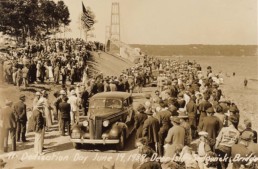
CONSTRUCTION COMMENCES
The contract for the substructure—the piers on which the towers would stand—was given to Merritt-Chapman & Scott of New York. The superstructure work was awarded to the Phoenix Bridge Company of Phoenixville, Pennsylvania. Despite frequent bad weather, work proceeded throughout the winter of 1937–38. Divers made test borings and cleared mud from the proposed pier locations in the waters between Sargentville and Little Deer Isle. Prefabricated iron forms were built to fit the rock formations at the site of the piers. Derricks lowered each section into place, and the seawater was pumped out, creating what is known as a cofferdam. These structures were then filled with concrete, forming a foundation for the bridge. Each of the bottom sections weighed about 135 tons. It was estimated that the job would employ 50 men working in two shifts. Additional work was announced for local residents, although not as much as originally promised, causing some initial unhappiness. By the spring of 1938, however, three shifts of men, including many previously unemployed from the area, were working around the clock to pour the 1,800 cubic yards of cement that it took to fill each of the cofferdams that formed the piers. Clayton Gross described the scene: “One of the things which seemed to impress people about bridge work was the appearance of the Reach at night. It was variously compared to a World’s Fair or to a major port, when the fleet was in, the area was so brilliantly illuminated by floodlights.” The steelwork and the cables connected to the towers were also prefabricated. The cables were spun on-site on large spools and stretched across the Reach. Girders for the suspension span floor were cut and put in place beginning with the center section. During the two years the bridge was under construction, there was one fatal accident and a number of minor delays due to winter storms. For the most part, however, construction proceeded on schedule. By October 1938 the bridge towers were completed, and in March 1939, the last span was connected to the tower on the Deer Isle side. In May 1939 the steelwork was completed, and in June, the bridge was opened to traffic. The dedication of the Deer Isle–Sedgwick Bridge took place on June 19, 1939, when Maine governor Lewis O. Barrows cut the ribbon stretching across the entrance to the $900,000 project. Bands played, automobile horns honked, and thousands of spectators roared their approval. Oscar Shepard wrote in the Bangor Daily News, “As the bright bit of silk touched the floor of the bridge, it was an island community no longer.” Barrows gave the keynote address, and speaker after speaker paid tribute to the spirit of the individuals who had made the bridge a reality. Congressman Ralph Brewster summarized the import: “After 175 years of geographical isolation, Deer Isle today becomes a part of Maine and of America. The union fulfills the dream of many men for many years.” In his 1989 history of the bridge, Gross wrote, “The construction of the Deer Isle–Sedgwick Bridge was probably the single most significant event in the history of Deer Isle.” The bridge motivated “an influx of retired people, a marked increase in the number of summer residents, larger numbers of transient tourists and young people who have vocations at which they can make a living. All of this has brought a change in the fabric of the island community.” In 1989, Hilda Eaton Stacher was even more succinct: “We are no longer an island,” she wrote. “How thrilled we were to see the president’s yacht, with FDR on board, sail under the bridge in 1940. It was just after he had the historic meeting with Winston Churchill off of Newfoundland . . . The island didn’t change drastically at first, though little by little we noticed changes.” The Deer Isle–Sedgwick Bridge was of a slender design similar to that of the ill-fated Tacoma Narrows Bridge in the state of Washington. That bridge, known as “Galloping Gertie” because of its “bounce,” collapsed in 40-mph winds on November 7, 1940. News of the catastrophe made Deer Isle folks uneasy, since their bridge over Eggemoggin Reach was also very sensitive to windy conditions. In December 1942 the Deer Isle Bridge faced its own ordeal. Seventy-mile-an-hour winds caused the bridge to oscillate so violently that many of the cable stays snapped, steel girders cracked, and general havoc was wrought. Bridge engineer David Steinman responded by adding a veritable cat’s cradle of stays that ran from the tops of the twin towers to the cables to the roadway. As a child, island resident Bill Haviland remembers that it was fun to walk out on the bridge on a windy day and feel it sway under him. Over the years the bridge would be closed periodically due to “undulations blamed on wind and heat,” Haviland recalled. The bridge has remained vulnerable to weather conditions, and has needed to be patched and repaired by cables and braces to protect it from gusts and gales.

TOLL AHEAD
For over 20 years bridge tolls were considered prohibitively expensive, and were an ongoing cause of irritation to islanders. The round-trip toll of $2 represented a significant portion of a paycheck when many people were earning less than $30 per week. Haviland remembers his father telling them as children to get down behind the seat when they came up to the tollbooth to avoid the extra passenger charge. And the $2.50 charge for trucks discouraged land shipments for years. As a result, for a long time after the bridge was built, granite still was shipped by barge or schooner to Boston or New York. Then there’s the story of two drunks who drove up to the bridge and tried to cross without paying because they were broke. They were stopped when their car hit a fence just past the tollhouse. The toll collector later said, “If only they’d told me they didn’t have any money, I’d have let them across.” Tolls were gradually reduced until, in 1961, an irate crowd of islanders packed the Legislature’s Highway Committee hearing room in Augusta to lobby for the final removal. In the face of heavy pressure, a bill was passed, removing tolls from the bridge on September 15, 1961. Driving over the 2,308-foot span is like going up and down a small hill. Bill Haviland tells the story of when his two aunts visited from New Brunswick in the 1940s. As they approached the span they thought it was a drawbridge that was raised. They waited for 15 minutes before realizing their error. Although the Tacoma Narrows Bridge tumbled into Puget Sound in 1940, just a year after both bridges were built, three-quarters of a century later, the East Coast cousin remains sensitive to wind conditions but still spans Eggemoggin Reach. With a few exceptions, all the goods and services for Deer Isle cross the bridge. While Stacher was technically accurate in her “We are no longer an island” proclamation, much of the special, old-Maine quality of life remains, as visitors and residents well know.
Caring For Their Own
Caring For Their Own
“The family became so destitute that they were obliged to seek alms from the town. An official from Stonington took the child when she was six years old and started with her for the Poor Farm on Deer Isle.”
— Dr. Benjamin Noyes, Island Family Histories: 1890–1945
Fortunately, this story has a happy ending. Lucetta Kinney heard the little girl crying while passing her home. Not having any children of her own, and pitying the little girl’s condition, she took the child into her home where she and her husband, Ezekiel, brought her up, changing her name to May Kinney.
The concept of the poor farm (or town farm) in Maine originated in the 19th century. During these years, Maine towns began to support people who were unable to care for themselves or their family members. At the time they were described as “indigents” or “inmates.” A poor farm might have included the homeless, unemployed, elderly, orphans, physically disabled, and mentally challenged, as well as single mothers with children.
Prior to the establishment of a poor farm, Deer Isle handled its indigents in a variety of ways. Beginning in 1817 the town voted the sum of $500, “to allow town overseers to expose [notify the public of] the sale at public auction of the poor of the town to the lowest bidder.” Then, in 1842, Edward Small was paid $485 yearly “to care for paupers.” A few years later the town voted to “instruct the overseers of the poor to make sufficient accommodations at the poorhouse for paupers, and to bind out all the paupers that they have a chance to,” suggesting that there was still a need for permanent accommodation.
Joseph Weed, a longtime resident of Deer Isle, was born in 1794. He and his wife Judith were married for 60 years, and he was described as “very industrious, prudent and a good citizen.” He even worked as the town’s tax collector for a number of years. As an old man, however, Weed fell on hard times. Ironically, the former town employee’s lands were taken over by the town shortly before his death in 1855. George Hosmer’s An Historical Sketch of the Town of Deer Isle, Maine, notes that “The town obtained possession of Joseph Weed’s farm and used the premises as a Poor Farm.”
Connie Wiberg, archivist at the Deer Isle-Stonington Historical Society, says that in 1860, David Torrey, a cooper who lived on North Deer Isle Road, was put in charge of the former Weed farm, “[running] it for the town as a Poor Farm.” Torrey, age 53, and his wife Eliza, age 47, took care of 12 people who were termed “insane, pauper and idiotic,” and ranged in age from 18 to 90.
The town sold the farm in 1881 for $325 to George Blastow, who ran it as a private operation for a number of years. When the Blastow farm closed in 1907, Deer Islanders returned to their previous approach of boarding out indigents to individual families. In the early 20th century there were anywhere from 6 to 15 people who were maintained in private homes at public expense.
The old Weed farm was not the only poor farm on Deer Isle, though it was the most significant. Records indicate that in 1882, a man named George Gray operated a poor farm on Center District Road, in a house now owned by Hugh Frey. No other information is available, though it was apparently “the last Town Farm on the island.”
Silas Banks is an interesting example of the kind of person the town cared for in these poor farms. As described in Hosmer’s history of Deer Isle, Banks “fell into distress after his father gained a settlement here, and the town was holden for his support and was obliged to provide for and remove him until his death in 1872.” The description adds poignantly, “He was a very witty person and in some things possessed a good deal of shrewdness.”
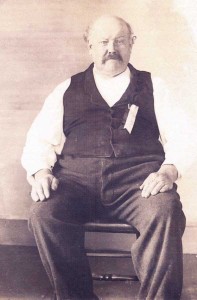
Perhaps Deer Isle’s most notorious case was that of Betty Bryant, who arrived from Braintree, Massachusetts, in the late 18th century. Bryant taught at island schools for many years, but is best remembered as Deer Isle’s only witch. Suspicions were aroused when cattle mysteriously began to escape from their barns even after the doors were locked. When island children began having “fits,” Bryant was accused of “casting an evil eye” on them, and parents would beseech her to remove her “spell.”

By the time she was an old woman, Bryant had become a town charge. A certain tale, elaborated on over the years, describes how she had hidden her life savings under a tree in the woods. One day a town selectman took her to the woods in an attempt to help her locate the spot. As the years passed, hunters trying to shoot rabbits in the area “found their shots ineffectual as the rabbits scurried to cover unhurt.” The theory was that Betty had cast a spell over the area.
One Sunday morning some hunters stopped at the poorhouse where Bryant lived. She proceeded to “admonish them for hunting on the Sabbath day. . . . Her old form shook with passion.” The story goes that an old soldier then loaded a silver button from his military coat into his gun and shot a rabbit. When the hunters returned, Bryant was found dead, killed by the silver button.
Dr. Benjamin Noyes, who compiled a history of Deer Isle in his book, Island Family Histories: 1890–1945, wrote, “Many ridiculous events I have heard attributed to [Betty Bryant’s] power, and the stories, probably losing nothing in the telling, have passed down to the time within my memory. Intelligent people repeated these fanciful tales and no doubt many believed them.”
Islesboro’s resident historian Paul Pendleton is in his 80s and has lived on the island his entire life, except for a three-year stint in the navy during World War II. Pendleton remembers when the Islesboro Poor Farm was operating and Melvin Grover was the caretaker.
According to Pendleton, an Islesboro poor farm opened in the late 19th century, when the island’s population was double what it is today. Starting in 1850, the town spent $300 annually to support “six native paupers.” In 1860 the number had risen to 27 paupers, who cost the town $575. By 1880, however, Islesboro’s town register notes the number of “indigents” had dwindled down to 5, “expense unknown.”
As noted, Melvin Grover was not the first caretaker of the town’s poor. In 1926 George Sherman was paid a salary of $1,300 to manage the poor farm. Four years later the Great Depression had already begun when Don King took over as caretaker. It was King’s misfortune that the caretaker’s salary had been reduced to $1,200 by the time he assumed responsibility in 1930. From there it only continued to decline.
Prior to assuming the caretaker’s job, sometime in the mid-1930s, Melvin Grover had worked as a butcher and an island handyman, and, until cars came to the island in the 1930s, he was also the town’s mailman, delivering the post by horse and buggy.
Grover needed a stable job and money to support his growing family when he took over the poor farm. “He had lots of children,” Pendleton remembers. “He was only married once, but he and his wife had two sets of kids, probably seven or eight in all. When one batch grew up, they had a few more.” As of 1943, however, Grover was still only paid $750 to manage the poor farm. Clearly the island was still feeling the effects of the Depression.
Usually there were between six and eight residents on the farm that Melvin and his wife managed. Most were men and women in their 40s and 50s, and all were described as “mentally unstable.” Paul cited the case of an elderly woman who died, leaving three sons. The young men were unable to manage for themselves, so they were sent to the poor farm.
Pendleton recalls that Grover “probably ran the place for 10 years, until he started to decline mentally in the early 1940s.” Grover’s mental problems became apparent in 1943, when he ran away from his job. The whole island turned out to look for him, including Pendleton, who found Grover hidden in a barn about a mile from the poor farm. Pendleton knew he was there when he heard coughing up in the hayloft.
Melvin Grover died the following year, when Paul thinks he was in his 60s. Knowing he was mentally unstable—indeed, possibly suicidal—the town had lined up a less-stressful job for him, working in a Camden shipyard. However, when a man arrived to help him move to Camden, Melvin ran away again, and this time, committed suicide.
Following Grover’s death in 1944, the remaining town poor went to live in Idella Wentworth’s house on Oregon Road. Idella lived alone and ran the place herself. In 1946 the town budgeted $3,000 to pay the costs of managing, boarding, and burying the people who lived with Idella. “At that point,” Pendleton says, “no one was in such bad shape that they had to be restrained.” There were, however, a number of references for “doctors’ care” and “hospital expenses for Roy Whitten” in the town records.
The 1946 Annual Report of the Town of Islesboro additionally listed $315 spent to send Lena Dodge to the Murray Nursing Home, and $615 paid to the New England Home for Little Wanderers, for Peter and Darrell Dodge. By 1959, however, everyone living with Idella Wentworth had either died or been sent away.
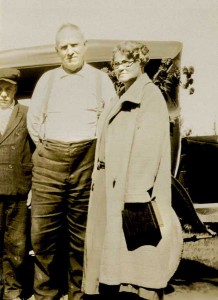
Growing Up on the Poor Farm
For most of the 19th century, Vinalhaven residents unable to care for themselves were boarded with other families at the town’s expense. In 1894, when it became difficult to find enough places to board these residents, the town bought a building that had been part of a large farm on Vinalhaven’s eastern shore, and the island’s poor farm came into existence.
Records in the Vinalhaven Historical Society indicate that the land and buildings originally cost the town $900, “including three bedsteads, four carpets and curtains.” The poor farm operated from 1894 to 1943, and had seven different managers—or “proprietors,” as they were called—including Lorenzo Bunker.
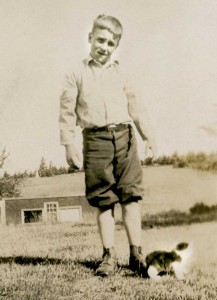
Lorenzo Bunker’s son Woodrow was born in 1918, and has vivid memories of growing up on the island’s poor farm (although he always felt this was a derogatory term). His father Lorenzo got the job as superintendent in 1924, and was paid $30 a month. Woodrow Bunker remembers that when they arrived, there were nine elderly people living there. Each had his or her own room with a bed, bureau, and a couple of chairs. They also had a lamp and a box of matches. “Can you imagine nine old people carrying lamps around?” Woodrow recalled in an interview before his death in 2006.
When the Bunker family arrived, the building had no electricity or running water. Drinking water came from a spring located 600 feet away from the house. Bunker remembers lugging two buckets of water at a time and dumping them into the old washtub, and filling the boiler for his mother. Mrs. Bunker had her hands full doing the cooking and cleaning, along with caring for her own five children and two elderly women in wheelchairs. (There is no mention of Mrs. Bunker receiving a salary.) Some of the residents came and went, but most stayed until they died.
Bunker’s father Lorenzo tended a large garden, milked the cows, cared for the animals, did the food shopping, cut the wood, and stoked the stoves. He also slaughtered the pigs when needed. Bunker remembers, “Some of the elderly might have helped with chores, but not often.”
Bunker lived with his family on the farm from 1924 to 1936, and recalls “a beautiful boyhood.” He fished, played with neighborhood boys, and rode to school in a horse-drawn wagon. High school students weren’t allowed to ride this “bus,” so at that point he had to walk. “I’d walk home at night, have supper, walk back down to play basketball, and then walk home again. I was getting 16 to 20 miles each day just walking.”
Bunker has vivid memories of some of the residents:

“Ninety-year-old Jane Springer would slip out her window at night and head for town like she was sixteen. My father used to go chase her and bring her back. . . . Frank Pease was a big man who probably weighed 300 pounds. He drank a quart of tea with every meal and read the Bible a lot. . . . Fanny Dyer cured the warts on my hands. I was always grateful to her for that, but I don’t know how she did it.”
Then there was the peripatetic William “Hunk” Beverage, who must have set a record for leaving and returning. Bunker describes him as “coming in and out as he found work.” Beverage was admitted in March 1926 and left the next month. He returned in November 1932 and left in February 1933. He was admitted in November 1933 and left in January 1934, only to leave again in March of the same year and return in November 1934. Beverage came and went a total of 12 times before his death in 1941.
Priscilla Chilles Rosen remembers going to the poor farm on weekends to visit her cousin Mary when she was in high school. (Priscilla’s uncle, John Chilles, managed the farm from 1940 to 1943.) Priscilla told me, “Most of the people were infirm and didn’t have anyone to care for them, but they did have a good vegetable garden and ate well.”
Longtime North Haven resident Lewis Haskell remembers two brothers, Wilbur and Rome Norton, who lived on North Haven. When their father died Wilbur inherited the family farm. Since Rome was unable to care for himself, the town of North Haven paid for him to live at the Vinalhaven poor farm.
There is no record of a North Haven poor farm, although there are listings for “Support of the Poor” in the town’s annual reports. These go back to 1837, when Nelson Carver was listed under “Poor Children Bound Out.” Nan Lee at the North Haven Historical Society says that the town paid for a number of individuals to “board out,” which extended to supplying clothing and general supplies to the poor. North Haven also paid the costs of an “Insane Hospital” and a “Home for the Feeble-Minded” for two people. Interestingly, even today, one of the North Haven selectmen’s titles is “Overseer of the Poor.”
Poor farms were not a complete drain on the island economies. By producing milk, vegetables, wheat, eggs, pork, beef, and veal, they were able to defray some of the operating expenses to their respective towns. In 1897 produce on the Vinalhaven poor farm amounted to a profit of $282.69, and on Islesboro, a 1931 entry reads “Received from Town Farm, labor and produce, $1,032.73.”
The End of the Poor Farm Era
In the first part of the 20th century, the populations on Deer Isle and Vinalhaven dropped significantly due to the decline of the granite industry. This was followed by the Great Depression and World War II, which further reduced island populations. Men and women left to look for work on the mainland, and, in the case of World War II, many joined the armed forces.
Vinalhaven’s population declined from 2,334 people in 1910 to 1,427 in 1950, a drop of almost 39 percent. Islesboro, which never had as large a population, went from 697 people in 1930 to 529 year-round residents in 1950, a decrease of 24 percent. Similarly, Deer Isle lost 1,000 people from 1910 to 1950.
Island populations continued to decline until the 1970s. With the extension of state and federal social services, including the Social Security Act in 1935, the need for poor farms disappeared, although Islesboro’s Idella Wentworth carried on until 1959.
In 1946 George and Ann Harwood bought Islesboro’s poor farm for $1,800. Today their niece and her family still spend their summers in the renovated farmhouse. The Harwood house sits on a hill on 59 acres at the north end of the island. On a nice day one has a beautiful view across the waters of East Penobscot Bay to Castine.
The original Joseph Weed farm on Deer Isle went through several more owners until it was sold to John and Marcia Winn in 1941. Winn family members and their relatives have owned the property to the present day. In 1928 the owner was Otis Howe, who named it “The Larches,” as it is still known today.
Except for the occasional squatter, the Vinalhaven poor farm sat empty until 1956. That year Mauricio and Emilia Lasansky bought it from the town for $1,500 and began fixing the place up. For years Lasansky family members used or rented out the building for printmaking and other artistic endeavors, including sculpting, dancing, and poetry writing.
Horace and Alison Hildreth bought the Vinalhaven poor farm in the 1990s and have continued to rehabilitate the old building. When I told Alison I’d heard rumors the place was haunted, she related the following tale.
The Hildreths had been renting the farm to a group of graphic designers on retreat for a number of years. One night when everyone had gone to bed, a bloodcurdling scream was heard. A young man bolted from his room on the second floor. Apparently he had woken up and seen what appeared to be a young woman standing at the end of his bed. He was so startled he didn’t wait for her to disappear, and fled from his room. He insisted on sleeping elsewhere for the rest of the retreat.
When Alison relayed the story to her family, her daughter-in-law said her aunt had slept in the same room and had had the same experience.
Alison herself has stayed in the room many times and has never been bothered. “Ghosts don’t make themselves visible to everyone,” she said. “It isn’t all nonsense. If they were ghosts, they were friendly ghosts.”

